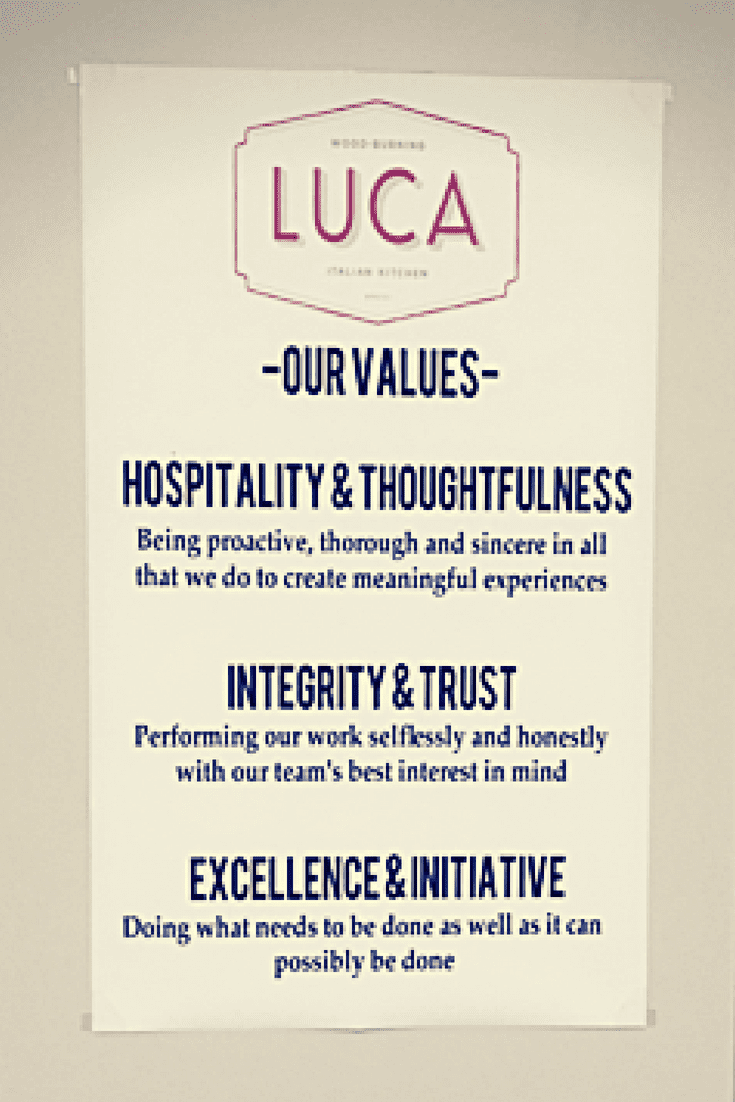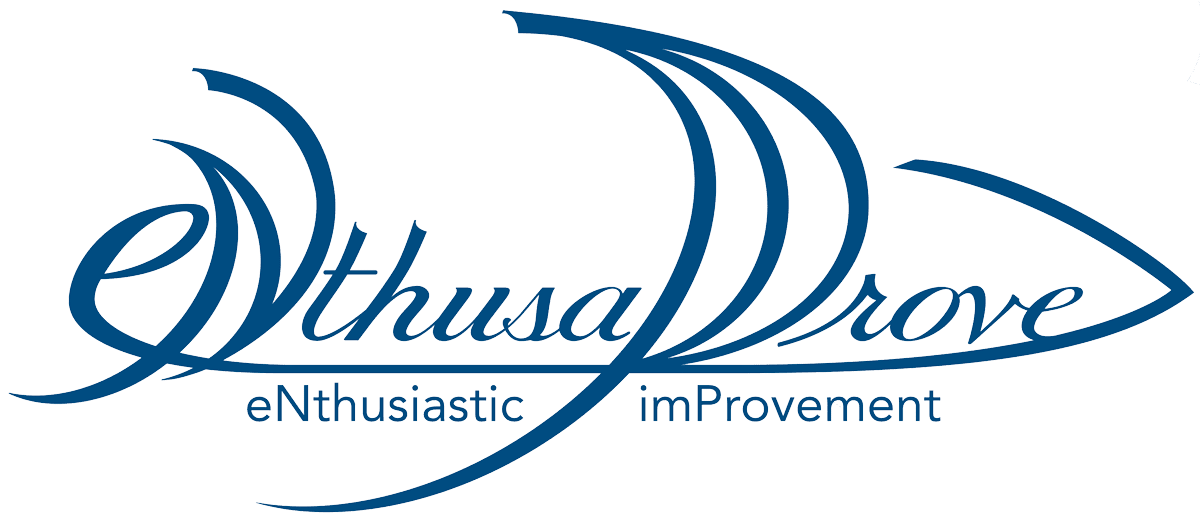 Does Your Team Know What You Value?
Does Your Team Know What You Value?
Over the years, I have used organizational value statements in helping executives clarify their strategic vision and put it into a plan.
Too often, when drilling into their values, I find that even the Execs aren’t really sure what they mean in a day to day context. When that is true, I worry that maybe it’s just a sign on the wall.
Do you, Team Leader, share with your team/business what you value? Are they guiding principles that inspire the team to greatness, or just a poster to check the box that we have created a values document as part of our charter?
Recently, I found a delightful example of how a local Leader has defined and lived out his values in his restaurant. This Leader exemplifies the four principles of using value statements to guide your business/team.
JoValley and Luca, partners in farm-to-table food
One of the joys that Diana and I (Paul) have in our life in Lancaster, PA is to grow some unusual items and then have them procured by discerning chefs. Our biggest customer is Taylor and Leeann Mason, who own a set of two acclaimed restaurants here in Lancaster, Ma(i)son and Luca. We have had the pleasure of teaming with them for several years.
We have a small farm, more like micro-farm in Lancaster, where we fill a niche for foods that Taylor and Leeann’s restaurants need and, God willing, we grow and harvest. I am guessing that we are one of his tiniest providers, and we certainly are not experts. As a result, we are quite humbled to get to supply his restaurants on a regular basis. We deal mostly with Taylor and he treats us with sincerity and respect every time we talk about what he needs and what we’re growing. (That’s a clue). For those who may be in the Lancaster area, you’ll soon hear of both restaurants, Ma(i)son and Luca. They are well respected.
So, as a matter of disclosure, I asked Taylor’s permission before writing this blog and he has read this blog and consented to its publication.
CASE STUDY: A value mindset shift: Entrepreneur to Leader.
Taylor started with Ma(i)son, a small establishment that seated less than 50 people. He was the entrepreneur/chef/owner. Then he opened Luca, a much larger restaurant, and therefore a sizable jump in staff. He realized that this is a whole new calling. (For more insight on this, you might like to read E-myth Revisited). He realized that he is not just the entrepreneur, the creative chef…he’s the leader.
And, as a leader, he had his team looking to him for all sorts of stuff, but now there was a new challenge… how to enable joy in work with a larger staff, every night as the restaurant teemed with customers with high expectations.
I’ve seen Taylor doing a lot of roles in that restaurant, everything from planning the ambiance to greeting customers to working with the pizza dough; in my opinion, he reflects the humility of a serving leader. Knowing what I do about Taylor, having experienced Luca at 7am and at 7pm, I see a few lessons to share.
When recently dropping off some ramps, I took note of this sign in the stairwell to the downstairs kitchen. The placement is intentional; it’s seen on every trip to the kitchen. It’s huge. It’s bold.
Many of you may be looking at that and not seeing anything extraordinary…and that’s good.
Principle #1: Vision statements don’t have to be anything exceptional…they just have to be true.
According to a recent article in Harvard Business Review, 90% of them reference ethical behavior or use the word “integrity,” 88% mention commitment to customers and 76% cite teamwork and trust. Actually, that same article makes a pretty good case (this is HBR for goodness sake!) for banning these words from your value statement: Ethical, Teamwork, Authentic, Fun, Customer-oriented.
Right off the bat, we see that Luca has not used the ‘banned’ words but they do employ the well-used ‘integrity’ and ‘trust’ labels. But notice that these terms are put into the context of the Luca business, and, in a way that emulates the connect and contribute components of enabling joy in work: “Performing our work selflessly and honestly with our team’s best interest in mind.”
You don’t have to have flashy statements or complex words to describe your values.
What will matter most is if the team sees the values in action. Leaders are communicating values with each moment, action, email. These statements let the rest of the team know what the leader will be demonstrating himself/herself and valuing in the team’s actions. Are the values you demonstrate consistent with what you’ve posted on the wall?
Principle #2: People have to know how those values look in the context of the business.
Why? Because many of the terms we find in value statements, and I’ve seen a lot over the years, are very similar. The generic terms leave us wondering what to do. This is why I like the clarifying statements Luca adds to each value. They tell you exactly how teammates are expected to apply the value in work, no matter if they are host, waiter, cook.
Principle #3: Your team has to know that the values are doable everyday, not just special occasions.
Excellence and initiative – wow… can we really be excellent every day? Aristotle stated that we do what we practice, that excellence isn’t an act, it’s a habit. Luca’s explanation of excellence and initiative is so clear, that I almost think the terms excellence and initiative could be left off: “Doing what needs to be done as well as it can possibly be done.” This resonates so well with the create value component of joy in work. Notice – this is about doing what needs to be done, implying it might not be in your job description. As I stated earlier, I see Taylor, the leader/owner/chef/entrepreneur exemplify this.
“As well as it can possibly be done.” This is a refreshing translation that too often I see explained as doing your best. This compares the task at hand with how well you are at that task. So, if I’m filling in as a host, but I’m really the bartender, then I know I won’t be excellent…but I can do what needs to be done as well as it can possibly be done (by me, anyway).
Principle #4: Help people see why these values are vital to the work at hand.
Those top values, “Hospitality and Thoughtfulness”. In my opinion, perfect for a business that is in the business of serving others. This a neat twist on uniquely stating a category value as a core value. (again – take a look at the HBR article). And again, it’s the subtext that is the real meat. “Being proactive, thorough and sincere in all that we do to create meaningful experiences.”
I like that the words “for the customer” is not in this sentence. This allows us to create meaningful experiences for our teammates as well as patrons.
You and Your Team
Over the years, I have used organizational value statements in helping executives to clarify their strategic vision and put it into a plan. When we compare the vision to guiding values, I find those driven Executives aren’t really sure what they mean in a day to day context. That tells me that the values in action may not be what’s on the wall.
As team leaders, many times you are the owner/chef/entrepreneur and, of course, leader. If you want your team to be aligned in all the tasks that span your team’s horizon, then you first need to help them know how to align on values.
My advice is to take a lesson from the subtext sentences on Luca’s sign: Put your team values into statements that make it clear what the values will look like, day to day, in the heat of battle and in the celebration of success…and, as the leader, Live Them. That diligent effort to enable joy in work on your team pays dividends, as Luca found to perhaps become one of the most admired teams in the area.






How do you help your team understand your values? I have a team that isn’t very aligned, and I’m not sure how to get them on the same page.